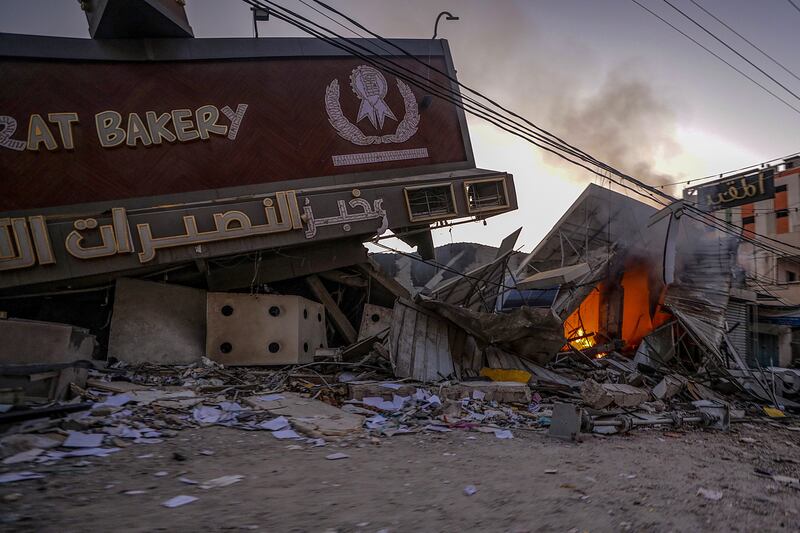The unemployment rate for Palestinians will almost double in the fourth quarter of this year with the Israel-Gaza war continuing for more than two months, according to a UN agency.
The jobless rate in the Palestinian territories will reach 46.1 per cent in the last three months of 2023, compared to 24.4 per cent in the same quarter of 2022, according to the latest projections by the International Labour Organisation (ILO) and the Palestinian Central Bureau of Statistics (PCBS).
At least 66 per cent of jobs in Gaza have been lost since the war erupted on October 7, worsening the already devastating economic situation in the enclave, the report said, in an upward revision of earlier estimates. That loss amounts to 192,000 jobs.
“As the intensity of the conflict spreads to southern Gaza, job losses are expected to grow further,” it said.

In the occupied West Bank, where continuing hostilities are also increasingly hurting economic conditions, employment has fallen by 32 per cent since October 7, which amounts to 276,000 jobs, the data showed.
About 468,000 jobs are estimated to have been lost in the Gaza Strip and West Bank as of November 30, compared to an earlier estimate of 390,000. That total translates into daily labour income losses of $20.5 million.
“The Palestinians of Gaza are in the midst of a humanitarian catastrophe of epic proportions,” Ruba Jaradat, regional director for Arab States at the ILO, said.
“The repercussions on the lives and livelihoods of affected communities are beyond anything seen in the Occupied Palestinian Territory before. The economic, social and development impact also has grave cascading implications for the labour market, not only in Gaza but also in the West Bank.”
The impact of the Israel-Gaza war is unprecedented compared to previous hostilities in the enclave, unleashing colossal destruction on lives and livelihoods.
The effects of the conflict have spilt over into the West Bank’s economy through tightening movement restrictions, closure of the Israeli labour market to Palestinian workers and disruptions to supply chain networks.
Israel continues to bombard the enclave of 2.3 million people, destroying infrastructure and killing residents.
Almost 20,000 Palestinians – mostly women and children – have been killed in Israeli strikes since the start of the conflict.
The current escalation of hostilities has exacerbated pre-existing economic challenges in the besieged enclave, making “Palestine unlivable for Palestinians”, the Palestine Economic Policy Research Institute (MAS) said in November.
Even before the war and the tightening of Israel's economic blockade of the Gaza Strip, around half of its population lived below the poverty line.
The continuing war has significantly hit all aspects of life, resulting in a humanitarian, social and economic crisis, Ola Awad, PCBS president, said.
“The crisis has caused a huge distortion in the Palestinian economic structure. The unemployment rate in the Gaza Strip now exceeds three-quarters of the labour force, and around a third of the West Bank's labour force is unemployed, reaching the highest level of unemployment in decades.”
The escalation of hostilities has also led to a scarcity of basic necessities for the people of Gaza.
“The Palestinians of Gaza face severe shortages of food, water and shelter, leading to an almost complete destruction of the economic cycle, and causing the Palestinian economy to lose more than one-third of its production base,” Ms Awad said.
The Gaza Strip lost 84 per cent of its usual monthly production in October and November due to the war, with an estimated monthly loss of $200 million, according to the PCBS.
The remaining productive capacity of 16 per cent is made up of vital sectors that did not stop completely,
including the health sector, bakeries and part of the internal trade sector to meet people's food and medicinal needs, the statistics bureau said.
Gaza's injured and cancer patients arrive in Abu Dhabi on UAE flight

Worst-hit sectors
Employment will decline in all economic sectors except agriculture, according to the ILO and PCBS report.
Work in agriculture is forecast to remain stable and provide a cushioning effect from the loss of employment from other sectors.
“This is the only sector that is projected not to face substantial employment losses as workers either remain and/or enter this sector during economic crunch periods as a coping mechanism,” the report said.
Meanwhile, the industry, construction and services sectors are projected to record significant job losses during the fourth quarter of 2023, compared to the same period last year.
Replacement of women workers
Women may be replaced by men in agriculture, with a slight increase in the number of male workers in the sector and a decrease in female workers, according to report's estimates.
“Since many women work in this sector as subsistence workers, the rise in male unemployment may lead to men pushing out women in the sector,” it said.
Wages have also been affected. Average real daily wages are projected to decline four per cent to $23 in 2023, from $24 in 2022, the report showed.







